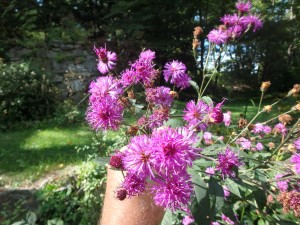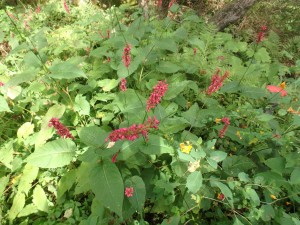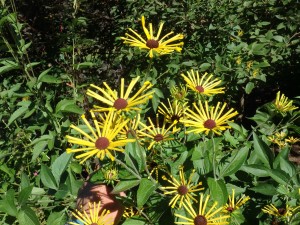Fall Flowers
Almost every flower gardener has great June flowers: peonies are dramatic and go well with the Siberian iris that bloom at the same time. Bachelor buttons are blooming and poppies are popping out everywhere. But now, in September, some gardens have plenty of green but lack color. It need not be that way.
The first and easiest “quick fix” are the chrysanthemums that are for sale everywhere. Although many are sold as “perennial”, I treat them as annuals. That is because it order to get a clump of mums to have hundreds of blossoms, someone has to cut back the growing stems at least once, and probably twice.
After cutting them back in June, each stem sends out two or more new branches, each of which should flower. But on the occasions when I have let mums come back, I rarely did that. So to me, it is worth just buying new ones every year.
The same technique of cutting back early stems is used for those intensely purple fall asters that are for sale at farmers markets and grocery stores. I love them, and I am willing to pay someone to create that dense crown of blossoms. I often put them along my front walkway or keep them in pots on the front steps. Left on their own, they get much taller.
But what about perennials that come back every year? Sneezeweed (Helenium autumnale), tall New England asters, turtlehead, Sedum ‘Autumn Joy’ and Joe Pye weed are commonly planted. But let’s look at some others you may not know.
A lesser-known plant that has been flowering for me for many weeks and still looks good is pink bistort (Persicaria bistorata Superba, also called Polygonum bistorta). It has pink to red bottlebrush flowers that stand up 2 to 3 feet, rising above glossy green foliage. It is a skinny little flower – actually lots of little flowers on a forked thin stem. Each group of flowers is 2 to 3 inches. They grow, for me, near where my primroses bloom in spring – under an old apple tree with rich, moist soil. It does well in a vase.
Also in bloom for me is ‘Henry Eilers’, a named variety of Rudbeckia subtomentosa. It was found growing in the wild in Montgomery County, Illinois by Mr. Eilers, and introduced to the gardening world in 2003. It is unlike most black-eyed Susans (Rudbeckia) in that it has gaps between the petals, giving it a distinctive look. Each petal looks as if it were carefully cut out with scissors – with a straight edge and separated from the next, like teeth on a Jack-o-lantern.
Henry Eilers is usually a very nice plant and requires little or no staking. This year mine grew to be 6 feet tall and is flopping over. Each year any given plant tends to grow differently.
New York ironweed (Vernonia noveboracensis)is another tall plant in bloom for me now. According to my bible for flowers, a wonderful 800-page book called Manual of Herbaceous Ornamental Plants by Steven M. Still, ironweed likes full sun with moist acidic soil. I moved mine from such a location to a drier location with part shade. I did so because it was too vigorous and too tall and floppy, when given ideal conditions. Even so, it is about 6 feet tall and somewhat floppy. It has intense purple flowers similar to those short asters for sale right now.
Fall anemones (Anemone japonica and hybrids) are fabulous flowers, albeit a bit fussy. They come in shades of pink and white with lovely 5-petaled blossoms 2 to 3 inches across. I have lost them more than once as they really do not like moist roots in winter, but need plenty of moisture in summer. That’s a tough requirement. According to the book mentioned above, they want morning sun and filtered afternoon sun. But if they are happy for you they will spread and produce plenty of great fall blossoms. I’d say, plant them in rich dark soil in a well-drained location, and water regularly if it is a dry summer.
Another great fall flower is called “showy autumn crocus”, but they are not really crocus. They areColchicum, a different genus of bulb flowers. They look like crocus on steroids- they have 4 to 6-inch flowers on long tube-like stems. They pop up now without leaves; leaves appear in the spring, then disappear.
The stems have little strength, so they generally flop over. For me, they always flop over, except for a few of the doubles, which sometimes stand up. One way to avoid the flop factor is to plant a ground cover like myrtle or pachysandra in the same area. The vines support the flowers a little.
So go visit your favorite garden center. You might be surprised what you find – fall flowers are still blooming.
Read Henry’s blogs at https://dailyuv.com/





